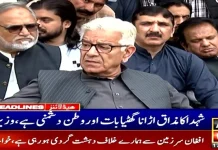The tensions between two nuclear and most populous nations China and India are rising in western Himalayan region.
A violent but non-armed clash on 15 June resulted in deaths of 20 Indian officers and soldiers including their commanding officer Colonel Bikumalla Santosh Babu.
As reported by Indian media a lieutenant-colonel and three majors along with other military personals were also detained by the Chinese security forces which were later released. Galwan flare-up is not a simple Indo-China military standoff but it imitates a similar situation at Kargil when Pakistan took India by surprise in 1999.
The Indian casualties are a result of a hand to hand fighting as no firearms were used by either of the security forces. Both India and China have barred the use of guns and explosives at Line of Actual Control (LAC) as a result of 1996 bilateral agreement.

This is first time in more than four decades that Sino-India border clash turned this deadly. After the clash China has declared that the sovereignty over the Galwan Valley area has always belonged to China.
Galwan valley is a relatively peaceful area of the LAC, where Indian and Chinese patrols did not come face-to-face unlike some other parts of their 3,500-kilometre (2,200-mile) frontier.
This is first time that Galwan area has become the bone of contention between the two countries as previously the area was never listed as one of the 23 contested areas identified disputed by the two governments on poorly defined Indo-China border.
Various factors are contributory to the existing conflict and its timing. Galwan is a secluded and barren area, where security forces are positioned on exorbitant cliffs. However, the area is strategically important being a pathway to the Askai Chin Plateau, which is claimed by India but administered by China.
The capture of Galwan valley provides the China strategic control of locations overlooking India’s Darbuk-Shyok-Daulat Beg Oldi (DSDBO) road, which connects Leh to the Karakoram Pass.
The 159 miles long DSDBO road runs analogous with the poorly defined LAC. The road is India’s gateway to its air base near the Karakoram Pass. India recently started the construction of feeder roads and links from DSDBO to other areas of LAC.
China had constantly raised concerns about the DSDBO road. A high-level military leadership meeting held on 6th June 2020 between Major General Liu Lin and Lieutenant General Harinder Singh in which China asserted the matter of its sovereignty on Galwan region.
China is also concerned about revocation of article 370 by BJP government. The revocation has not only deprived Jammu and Kashmir (J&K) from its traditional autonomy but also separated territory of Ladakh from J&K and established it as a Union Territory controlled by the BJP Central government. China remained sceptical that the move was driven by BJP domestic political agenda and not intended to assert Indian claim on Chinese-controlled Aksai Chin region. This provided a reason for China to initiate a standoff in eastern Ladakh.
Since the revocation of article 370 in August 2019; the BJP Government has implemented 37 laws of Indian central government in Kashmir. A new controversial domicile law has also been introduced.
The law which aimed to change Kashmir’s demography allows anyone who has resided for 15 years in the Jammu and Kashmir or studied for a period of seven years and appeared in class 10/12 examinations in educational institutions located in the J&K will be eligible to become permanent resident of the region.
To flareup matters further India recently issued a new map of India which shows the entire Azad Kashmir, Gilgit-Baltistan and Aksai Chin as part of India. The new Indian map also incorporated part of the areas under the local jurisdiction of Xinjiang and Tibet into its Ladakh union territory.
Amidst the Indo-China standoff in the region, on 11th June a Pakistan based Chinese diplomat Wang Xianfeng tweeted to convey his country’s position on developments in J&K.

The tweet read, “India’s actions of unilaterally changing the status quo of Kashmir and continuing to exacerbate regional tensions have posed a challenge to the sovereignty of China and Pakistan and made the India-Pakistan relations and China-India relations more complex”.
The Indo-China LAC conflict has proven the hollowness of the Prime Minister Narendra Modi’s 56-inch chest rhetorical claim. The Deputy Director of Information Department of Chinese Foreign Ministry Zhao Lijian has very precisely stated the Chinese position on the matter by saying, ‘ the Peoples’ liberation army are there to stay and if India wants to avoid conflict it’s up to New Delhi to restrain its forces’.





























